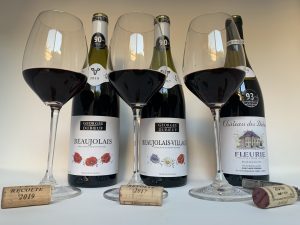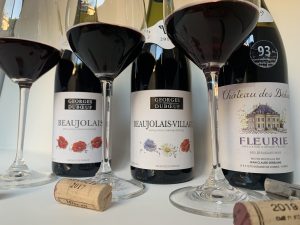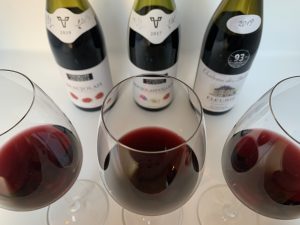This week, Beaujolais was on my list of wines to taste as preparation for my WSET exam. Until recently, I’ve stayed away from buying French wines, mostly because I was too overwhelmed by the labels and regions to truly understand what I was buying. The WSET has helped me understand the basics of French labeling and regions, so I’m here to help debunk the French wine buying process for you—starting with Beaujolais.

I hosted a wine tasting party (for myself!) on Friday night, and I opened three bottles of Beaujolais. The first thing you need to know is that Beaujolais is a French wine region, and it is permitted to grow Gamay grapes (yes, French law dictates what grape varietals can be grown in each region). As a result, all three of the wines in my tasting line up were 100% Gamay. Gamay is a grape that produces light-bodied red wine with medium-high acidity and red fruit flavors. It has similar body to Pinot Noir, but usually with slightly higher acid and tannin.
So, if all of these wines are 100% Gamay grapes, then why the heck are the labels all so different? Well, the French make their labels pretty confusing for consumers outside of the EU, so let me break it down for you.

From left to right:
Beaujolais:
A wine labeled as “Beaujolais” signifies that the grapes were grown within the Beaujolais region. This could be referred to as the “bottom tier” of Beaujolais wine. Wines with the Beaujolais label tend to be made from grapes that are part of high-yield vineyards. Vines are typically planted on flat land as opposed to more desirable hillside vineyards. A standard Beaujolais wine is made to drink while young and will most likely show simple, red fruit flavors without much complexity or depth.
Beaujolais-Villages:
A wine labeled “Beaujolais-Villages” means that the grapes used to make this wine were grown in specific areas within Beaujolais known for producing higher quality fruit. These areas are referred to as “villages”. Vineyards designated for Beaujolais-Villages wines are usually situated on south-facing slopes, which is the best orientation for vineyards in the northern hemisphere. Wines with a “villages” label should have more complex flavors and aromas compared to a simple “Beaujolais” label.
Fleurie:
Now, here’s where things get really confusing. The top tier French wines come from specific “crus” within a designated region. (You’ve probably heard the term Grand Cru, right?). Well, if a 100% Gamay wine is grown within one of 10 specific crus in Beaujolais, then the wine can be labeled according to the name of the cru itself rather than the name of the region. In this case, “Fleurie” is the name of a Beaujolais cru. Consumers of French wine who prefer to purchase high-end cru wines should know the names of crus in different regions in order to fully understand what type of wine they are buying and where it was grown. Fleurie is one of the most popular crus within Beaujolais. It features south-facing sloped vineyards that are known for producing some of the most concentrated fruit of Beaujolais. A cru wine should show the most flavor and complexity of the three Beaujolais labels.
I tasted the wines from left to right, and evaluated them using the WSET Standardized Approach to Tasting. The quality of the wines definitely increased from bottle-to-bottle, with Fleurie being the clear standout of the three.

- The 2019 Deboeuf Beaujolais was the cheapest of the three bottles, which cost me $10 or less. I found that the tannins in this wine overwhelmed my palate a bit, but I was still able to pick up on a few distinct flavors and aromas—namely strawberry and red cherry. The aroma intensity was light and the finish was short. The WSET quality rating was “acceptable”.
- The 2017 Deboeuf Beaujolais-Villages was distinctly better than the previous wine. It was a major upgrade in balance and flavors, and only cost me $11.50 for the bottle. Darker red fruit flavors were prominent on the nose and palate, and while tannins were still present they were not nearly as overwhelming as the first bottle. I got a hint of chocolate on the nose as well, perhaps a sign of the wine having a bit more age to it. The WSET quality rating was “good”.
- The 2019 Chateau de Déduits Fleurie was the most expensive of the three Beaujolais bottles, costing me just under $18. (This price is a steal compared to many other French wines!) Despite its young age, this wine displayed tertiary earthy aromas alongside ripe red fruits and baking spice. The flavor intensity was the strongest of the three bottles, and the tannins were the softest of the group. The Fleurie was bright and enjoyable, balanced, and complex. The WSET quality rating was “very good”.
Beaujolais wines are typically meant to be consumed while young, although some bottles of cru wines may age well over time. The youthful nature of these wines helps keep the price point low for international consumers. I bought these bottles at Total Wine and had no trouble finding a few to choose from.
If you’ve never tried Beaujolais or are just starting to learn about French wine, consider setting up a tasting like this one! It’s a great way to train your palate and hone in on the differences in quality between each bottle.
I hope my debunking of Beaujolais will help you on your next wine buying trip, or will at least inspire you to get your hands on a new varietal of wine sometime soon. Cheers!
Like what you read? Give it a share! And be sure you’re following me on Instagram to see what other wines I’m trying!

One thought on “Debunking Beaujolais: A Quick Guide to French Wine”
Comments are closed.